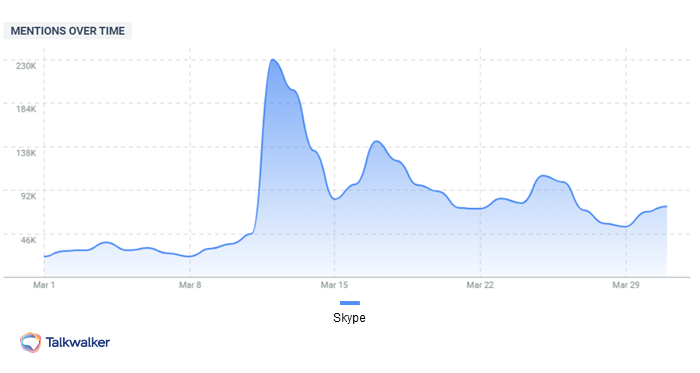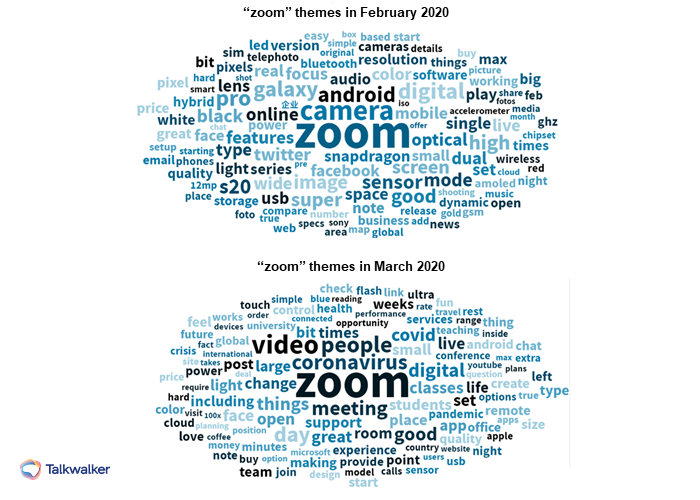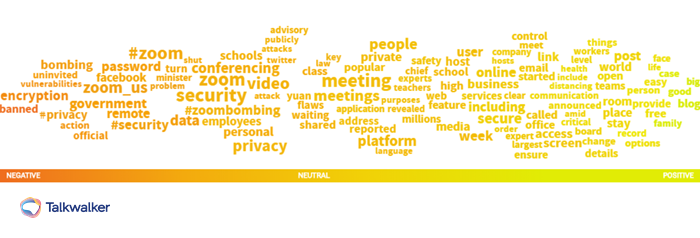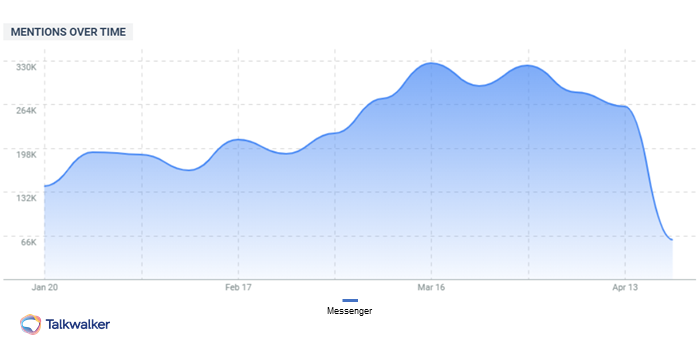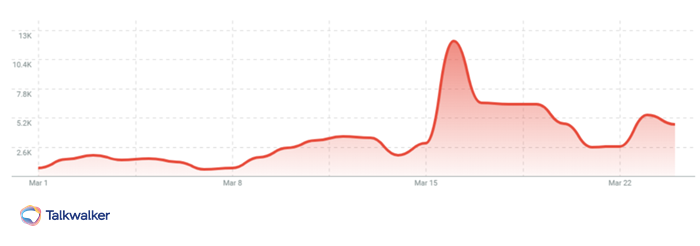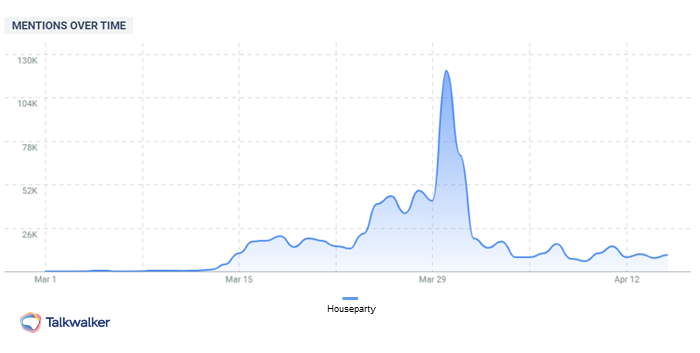DOWNLOAD: COVID-19 Industry Reports
The COVID-19 outbreak has created a new space for video conferencing, and potentially changed the way people will communicate going forward. In the span of a month, video chat has gone from a futuristic-feeling way to keep in touch to an essential part of our daily lives.
Mentions for top video chat platforms soared in the first weeks of the COVID-19 pandemic.
Many of the first companies to build modern video communication systems as we know them - Microsoft, Apple, Samsung, even AOL - were tech pioneers who saw the impact that video conferencing could have across business and personal life alike. But when cloud computing hit the scene, any company that could develop an easy-to-use tool with a good interface had just as much of a shot of being successful in the space.
my wife and I fell in love over Skype calls between Toronto & LA after meeting in Venice Italy. Thanks Skype!
— Murray (@yyzlax) February 13, 2017
In 2020, there’s a huge range of video communication platforms to choose from based on your needs. Some video tech providers like Skype have had more use cases with the public over the years. Social media platforms like Facebook have incorporated video into their messaging apps so that you can talk face-to-face with the click of a button.
Other video tech systems, like Cisco’s WebEx and the now mega-popular Zoom, mainly were used by businesses to streamline communication with customers and teams in different locations. Now, they’re getting a lot more traffic. And they may not be prepared for it…
The video conferencing service Zoom claims to implement end-to-end encryption. In fact, Zoom is using its own definition of the term, one that lets Zoom itself access unencrypted video and audio from meetings. https://t.co/7cLgLQVnp5
— The Intercept (@theintercept) March 31, 2020
So how are people feeling about all their video communication options, now that they’re the only option we have to see one another? I looked at five of the video chat providers that are making the most noise this year (for better or worse) to see how they stack up in our new “normal”:
Skype
Video calling is essential to maintaining personal connections with those who matter most to you. See the faces of those you love with group video chat and call up to 50 people for free on just about any device, tablet or computer. Learn more: https://t.co/lpUWMbXcpu
— Skype (@Skype) March 27, 2020
Skype was one of the first video chat platforms to become mainstream. At its launch in 2003, other messaging apps already had video capabilities. But Skype had one big thing going for it - as long as you had internet access, it was totally free to use.
That, and features like supporting up to 25 people in a chat at once, allowed Skype to grow into a globally recognized platform even as more competitors emerged. After being bought by Microsoft in 2011, it had the financial backing to keep building better user experiences. At the end of 2019, Skype was boasting 300 million active monthly worldwide users.
While those numbers were impressive going into this year, they’re nothing compared to what the COVID-19 crisis has done to boost Skype usage. In March alone, the platform acquired another 100 million active users. Microsoft also reported that Skype-to-Skype calling minutes are up 220%.
Skype’s mentions skyrocketed in mid-March when the shelter-in-place orders went into effect worldwide.
Clearly there’s no slowing down for this platform’s growth any time soon. But will the user experience live up to the increased demand?
@zoom_us is like the new babe in town, stealing my heart now from @Skype . So hot!!!
— Aemidr (@aemidr) April 16, 2020
Zoom
Comparing theme clouds between February and March for “zoom” shows a big shift in online chatter.
By the time of its IPO in 2019, Zoom had reached nearly 10 million active monthly users and earned coveted “unicorn” startup status.
Why is Zoom so popular? Their business model is simple - in founder Eric Yuan’s words, “[Our] main focus has been to provide a cloud video communications solution that would make customers happy. That focus has continued to guide all our innovations, partnerships, and other initiatives.” This attitude created a company ethos where the product speaks for itself, and customers have become brand evangelists.
Just set up Zoom phone for Ireland to test for a client.
Amazingly easy setup. @zoom_us pic.twitter.com/ZRut7qkuBU— Jared Huet (@jaredhuet) March 25, 2020
With coronavirus completely changing the face of communications this year, Zoom’s already staggering growth has gone into hyperspeed. The platform added more users in the month of March 2020 alone than in all of 2019.
While this is great news for the business’ bottom line, making the jump from tech-friendly office environments to living rooms all over the world has exposed a lot of Zoom’s security gaps. The video conferencing platform was first touted as a great solution for anyone newly working (or learning, or teaching, or socializing) from home, and that encouraged widespread use. Now, “Zoombombing” and concerns about encryption are exposing the product’s weaknesses.
In conversational themes around Zoom’s security, the sentiment is bleak.
With security issues taking over the recent conversation, Zoom’s marketing strategy has had to adapt to a less friendly climate. They have made a determined effort in recent weeks to clean up their image by adding product enhancements and features that make the platform more secure, and have used their social channels to promote these updates and refocus the discussion:
Zoom has been hard at work delivering additional features that further secure your Zoom meeting and webinar experiences. Here’s a quick overview of the new password options, Zoom’s random meeting ID generator, and other Zoom platform developments... https://t.co/Rux4KvIewI
— Zoom (@zoom_us) April 15, 2020
And while they’d already been playing in the corporate social responsibility space by giving free Zoom PRO accounts to educators at the onset of the crisis, the company is now providing even more resources around COVID-19 with a regularly updated support center and partnerships with brands and organizations that highlight their attention to the issues:
Join us April 22nd for a webinar w/ @whitedotspace, the Ministry of Defence and Impulsion Ltd to learn more on how to successfully transition yourself, your team and your existing projects from the office to home... Register here ⬇️ https://t.co/m8JttsMNFt
— Zoom (@zoom_us) April 17, 2020
The new ubiquity of Zoom has impacted other brands’ marketing strategy as well. With millions of people now working from home, companies that never would have been associated with video conferencing are suddenly are finding advertising opportunities in this emerging space:
It begs the question: what other industries are going to find themselves using video chat as their new marketing vehicle?
How was your industry impacted by COVID-19? Find out now.
Facebook Messenger
Facebook has been synonymous with socializing for over fifteen years now. While the company has had a lot of high-profile acquisitions that have allowed it to build out its product portfolio (WhatsApp, Instagram, Oculus, etc.), one of its most popular products is homegrown. In 2011, the company scrapped its desktop Facebook Chat function and launched the Messenger app. It’s become just as in-demand as the platform, ending 2019 as the #2 most downloaded app of the year - runner-up, naturally, to Facebook.
Video calling was introduced to Messenger in 2015, and since then tons of enhancements have been made to make it even more friendly and fun. The app was the first to allow up to 50 people on a video call at once, forcing platforms like Skype and Google Hangouts whose video chat capacities maxed out at 10 people to pivot their product strategy. Additions like filters and reaction buttons have given Messenger a foothold against Snapchat and other video communication apps in this competitive field.
Messenger video chat features masks and fun visual elements. (Via Facebook)
Since COVID-19 lockdowns began across the US, people are using Messenger more than ever to communicate. The app has seen a 30% uptick in activity since the beginning of the pandemic, and online conversation around the product has increased in response:
Mentions for Messenger saw steady growth as the quarantine lifestyle became a reality.
With the announcement of Messenger making a return to desktops this month, it’s clear that Facebook is keeping an agile marketing and product development strategy that will help them weather the current climate. Only time will tell how much more this social media powerhouse will be leaning into video communication technology in the coming months.
Stay sharp with these marketing resources
WebEx Meetings
Cisco’s WebEx suite has long been a SaaS platform of choice for enterprise companies, and is one of the most long-standing video communication brands on this list.
WebEx launched in the 1990s as a team collaboration tool, using features like virtual conferencing and “whiteboarding” to win over customers. It was purchased by Cisco in 2007 as a way to build out its SMB offering, and WebEx has evolved through the years since to include features like video conferencing, meeting recording, and integrations with other communication management systems. Recently, Cisco has been exploring AI implications for WebEx Meetings that would make cross-team collaboration even more efficient.
WebEx Meetings has been heavily used by the tech and education industries for project management, but the brand is gaining recognition in new markets now that the COVID-19 crisis has created the immediate need for virtual meeting rooms. Cisco reported that in the first two weeks of March, WebEx saw 5.5 billion virtual meeting minutes. Within the first month of the pandemic becoming a reality in the US, the company’s mentions had increased 421%:
Cisco’s growing user base correlated with an increase in online conversation around the brand.
This surge in conversation around WebEx and Cisco isn’t just because of its new foothold in daily life - “cisco” saw a 75% boost in engagement on 3/22 with the announcement of their $225M donation to coronavirus relief. The company also drove positive engagement around communication on their 90-day unlimited secure conferencing offering:
Cisco commits $225 million to battle coronavirus, leading tech’s fight against the pandemic https://t.co/KhSbO6XN1C
— FORTUNE (@FortuneMagazine) March 23, 2020
As with Zoom, increased scrutiny has Cisco reacting to new standards and a rapidly growing user base simultaneously. Showing efforts to answer to their customers’ concerns and adapt to a new global environment will help them come out ahead.
Houseparty
On the other side of the video communications playing field is Houseparty - the previously little-known platform has blown up in recent months and been positioned as the social video chat app of the coronavirus age.
Unlike the other video communication apps featured here, Houseparty’s appeal is its lack of security. The platform lets users upload their contacts and invite friends into a virtual room where they can video chat while they play games, share screens, and more. By leaving the room’s “door” open (AKA making the chat public), friends can invite others, who can invite others, and create a virtual party.
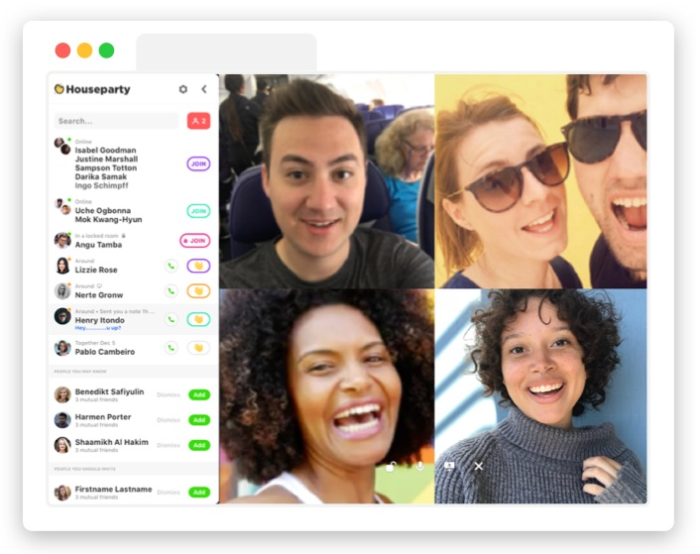
Houseparty’s “rooms” make face-to-face socializing a virtual experience. (Via Houseparty)
The app has been out since 2017, launched during the time of Periscope and other forgotten video streaming platforms; it’s an offshoot of Meerkat. While Houseparty was strong out the gate with an average of 1 million users per day, it lost its early steam and growth stalled.
That is, until very recently. Between February and March, the app’s download rate increased over 2,500%. Houseparty has withstood the influx of new users, and even changed some of its growth strategies to increase retention. In order to make the app experience more friendly during this anxiety-inducing period of time, Houseparty has made all of their paid game add-ons free of charge. The results speak for themselves:
People looking for new ways to connect with friends and family made Houseparty a hot topic in the last month.
Houseparty has the opportunity to shift their marketing strategy and ride the wave of popularity to even more new user growth. Feature limitations, like a block on to the number of people who can be in a chat at once (the current max is eight) may need to be rethought if the app is going to continue to be successful. For now, it’s become an unsuspecting player in the video chat game this year.
We’ve already seen an insane amount of upheaval in the video communications industry in 2020, and we’re not even halfway through the year. Whether you want to host a virtual Houseparty, Zoom conference your entire office, or Skype with family across town, you can find a video chat app that will work for you while we wait out the pandemic.
Each platform has its pros and cons, and our increasing need for these products will drive innovation in the space. What other features, security measures, and design elements are going to become important? Right now, one thing we can definitely be certain of is that video conferencing is no longer limited to the 9-5 office life.

